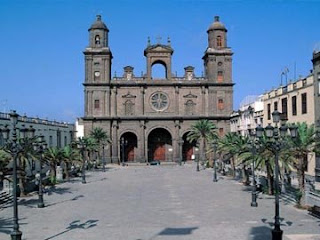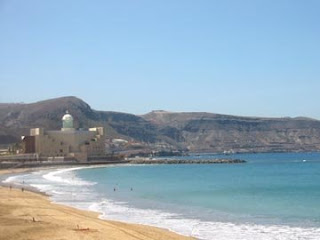that is how this island is called because of its extremely varied landscapes with European, African and even American vegetation. The mountain range in the island's center, of a height of about 2000 meters, is cut by some bizarre canyons.Hardly anywhere else you can find such different landscapes and even climatical zones being geographically that close one to each other: mountain massives, desert land, tropical forrests, ... Along the seaside there are wide beaches of sand, and while elsewhere people are shuddering of cold, here the tourists are lying in the sun and looking at those mountainpeaks being covered with snow ...
 The Beaches of Gran Canaria
The Beaches of Gran CanariaMaspalomas
Maybe the most beautiful among the fantastic beaches of this island. Fine white sand at a length of 6 kilometers and a width of up to 1 kilometer, and intensely blue sea ... a paradise for sunworshippers, in particular during the cold European winter! There are modern hotel-complexes and sports installations, more than anywhere at Faro de Maspalomas, with the island's most important sports harbour, Pasitoblanco. Along the beach there are several oasis with palms and even a fresh-water lake.
Playa del Inglés
Next to Maspalomas, of a length of 2.700 meters. This is one of the most famous beaches of the archipelago, with modern hotels and installations of any kind
San Agustín
Less known than the two foregoing, but quieter and more relaxing. An ideal place to recover from the stress of everyday life.Playa de Patalavaca: Another great beach with fine sand of golden color. Also ideal for sport-fishing.
Puerto Rico
A modern urbanization with hotels, appartments and a nice harbour. Its great sports installations are one of its main attractions.
Costa de Bañaderos
Beautiful landscape with romantical small bays.
Galdar
with a bizarre high coast.
Sardina del Mar
a picturesque fishing-village with nice beaches.
Playa de las Canteras
a wide beach of sand at 2,6 kilometers length, located directly in the capital, Las Palmas de Gran Canaria.
Playa de las Nieves
Nieve means snow in Spanish language, and this name comes from the high mountains directly behind this beach.
 Las Palmas de Gran Canaria, an original town
Las Palmas de Gran Canaria, an original townThe archipelago's capital, with 352.641 inhabitants, surprises the visitor with its highly original and individual architecture showing influences of all five continents, and its colorfully painted houses.
Ambience is very lively, being evidence of a population of southern temperament not always taking life at its most serious.This city's great cultural offer, attractive festivities and highly recommendable cuisine, as well traditional and regional as international, will make your stay memorable.
Don't miss ...
The Cathedral
of gothic and neoclassical style. Its construction was begun after the discovery of America. At the same square, Santa Ana, you'll find also the Archiepiscopal Palais and several nice buildings in the typical Canarian style of architecture.
of gothic and neoclassical style. Its construction was begun after the discovery of America. At the same square, Santa Ana, you'll find also the Archiepiscopal Palais and several nice buildings in the typical Canarian style of architecture.
The Barrio de la Vegueta is a very attractive quarter of town, with numerous manorial houses showing influences of latin-american colonial style.
In the Centro Atlántico de Arte Moderno you can see an important collection of contemporary art.
La Casa de Colón,
the "House of Columbus", reminds us that the ships of Christopher Columbus made a halt here on their journey to America.
the "House of Columbus", reminds us that the ships of Christopher Columbus made a halt here on their journey to America.
The Museo Canario,
the "Canarian Museum", shows the most complete exposition you may find about the islands' original inhabitants, the Guanches.
the "Canarian Museum", shows the most complete exposition you may find about the islands' original inhabitants, the Guanches.
The Pueblo Canario,
located in the beautiful gardens of Doramas Park, was created by canarian artist Néstor de la Torre and represents the islands' typical architecture. Each Thursday and Sunday take place colorful folkloristical performances.
located in the beautiful gardens of Doramas Park, was created by canarian artist Néstor de la Torre and represents the islands' typical architecture. Each Thursday and Sunday take place colorful folkloristical performances.
More sights to be visited are the Museum of Arts, the Museum Pérez Galdós in the house where this writer was living, and the Nestor-Museum, close to the Pueblo Español and created by the artist himself.8 kilometers out of Las Palmas there is the Jardín Canario, the "Canarian Garden". It shows the incredible variety of plants at the islands, with no fewer than 500 species existing exclusively here.

The word comes from Guan Chenech, which is how the natives of Tenerife called themselves in their own language. With the passage of time, the term Guanche became identified with the natives of the all the Canary Islands.
This population of white skin and tall figure is a mystery to historians. In the Canarian Museum of Las Palmas you will find a collection of some of the most interesting findings, but Guanches have left their tracks in all the island:
Galdar, here is located the Cueva Pintada, a cave with polychrome geometrical wall-paintings. The Arbol Sagrado, a very old tree in front of the town-hall, was one of this population's sanctuaries.
Telde:
this village, which is worth a visit alone for its beautiful landscape and great beaches, has in its surroundings one of the most interesting tracks of the Guanches as an additional attraction: the Montaña Sagrada, the "Holy Mountain", together with several caves which were habited by this population.
San Bartolomé de Tirajana:
You can arrive to this village which is "hidden" in an enormous volcanic crater only by narrow mountain streets, passing the island's highest mountains, Pozo de las Nieves (1.965 m) and Los Pechos (1.961 m). Close to it there is the Guanche's Necropolis of Artenara.
Temisas:
another romantical small village with fine beaches, offering interesting historical remains as an additional attraction.
In Malpais,
located close to Agaete, were made very important archaeological findings
You find here green valleys with cultures of almonds at the foot of the mighty mountain peaks Roque Nubo and Bentayga.
Teror The village which "seems to be floating in the air", is located at a tableland 575 meters above sea level.
It is surrounded by breath-taking mountain ranges. It is also a well-known place of pilgrimship and has several very nice houses in colonial style, as the Casa de Doña Teresa de Bolivar .
Arucas: This well cared-for old town with nice parks is located at an impressive high coast with picturesque small bays, and some of the island's most important banana-plantations. Very close to here there is the volcano Montaña de Arucas
Santa María de Guia
is located in the island's north. Here you may visit the Cenobio de Valerón, a group of caves enclosed by petrified lava.
At Agaete, located at the seaside, you can see an impressive canyon with plantations of papayas, avocados, coffee and bananas, and the Balneario de los Berrazales with its thermal springs.
In the south we find the most beautiful landscapes at Arinaga, which is a romantic fishing-village offering a great panorama, and Mogán, a beautiful valley with cultures of tropical fruits.


No comments:
Post a Comment